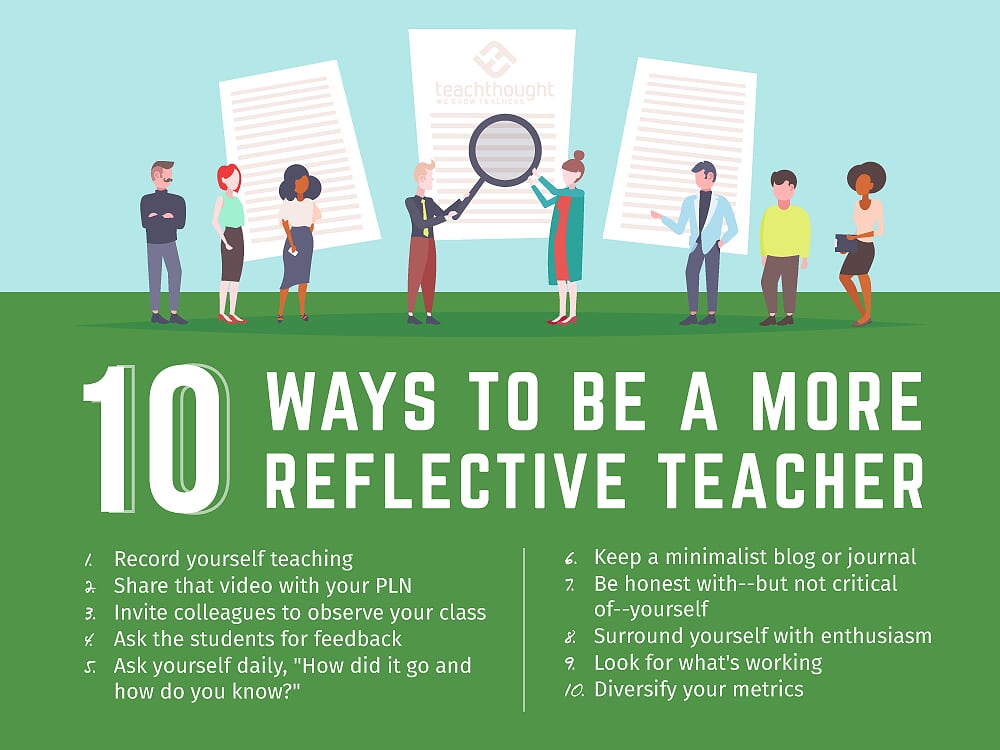
How To Be A More Reflective Teacher
Teaching isn’t easy.
It will challenge your content knowledge, pedagogical skills, charisma, diplomacy, communication, statistical analysis skills, and a dozen other strands you didn’t know where strands. Some teachers may try to tell you that being happy doesn’t matter. That it’s about results. Data. Performance. Or more rhetorically, the students.
Teaching is about the students, but guess what? If you can’t take care of yourself, you can’t help the students–not in a way that’s sustainable. We’ve talked before about surviving teaching. But what about setting the bar higher? What about being happy? And further, can you be happy and be a good teacher at the same time?
A key factor in happiness can be perspective, and a factor in effectiveness can be reflection. Below are 10 ways to be a more reflective teacher.
1. Record yourself teaching
This used to require awkward VHS systems and tripods that students would knock over–and that would distract them endlessly.
Today, it can be a matter of casually propping up your smartphone out of sight, setting it to record, and getting on with the lesson. In fact, you can even create a time-lapse (there are many apps that do this with ease) to track your movement around the room. You can watch the video with and without sound. You can even look for specific things–who talks the most, average wait time, clarity of instructions, etc.
And it doesn’t have to be video–just audio can be revealing, too.
2. Share that video with your PLN
And ask them to help you do the above, and offer feedback of their own. (Just be sure that students’ faces are blurred if you’re making the video public.) Every teacher needs a high-functioning Professional Learning Network.
3. Invite colleagues to observe your class
Not just the same few teachers, either. Ask them to be ‘critical friends’ and then thicken your skin. It’s not about you, it’s about your craft.
4. Ask the students for feedback
You might be surprised how good they are at guiding you in your work.
5. Ask yourself daily, “How did it go and how do you know?”
This is a question from Cognitive Coaching training, and it’s a useful tool to frame reflection. What are your general impressions, and what evidence do you have to support those impressions? Think of something right now that you believe to be effective. A literacy strategy, for example. Or a favorite unit. Maybe a no-zero grading policy.
You say it ‘works.’ How do you know? What can you point to as evidence? What would others say? What metrics are you using? (See #10 below.)
6. Keep a minimalist blog or journal
This doesn’t have to be anything ambitious–the point is reflection, not web design. Make it as basic as possible and try to blog at least twice a week–and don’t skip it if you’re feeling too tired or stressed to reflect. These can be the best times and writing about it can be therapeutic. You can even limit yourself to five minutes per entry.
The only goal here is to reflect–maybe create a list of sample prompts or stems to support the reflection. Then go back and read previous entries every now and then to see what you were thinking, when, and why.
7. Be honest with–but not critical of–yourself
So many potentially great teachers are blind to their shortcomings.
This is probably a kind of defense mechanism. That, or they really can’t see their hangups. No teacher is perfect, but reflection can help you identify those barriers that are keeping you from improving. This will require you to be honest with yourself; don’t rationalize your own mediocrity, but don’t tear yourself apart, either.
Reflect, iterate, and improve.
8. Surround yourself with enthusiasm
The more potential you see around you, the more you’ll observe, analyze, and design to try to fit some of those ideas in.
9. Look for what’s working
Don’t become addicted to fixing the broken bits in your teaching; celebrate what you do well. Identify your own strengths, and use them to transform your teaching. If you’re good at tinkering, use that in your teaching no matter the content area. If you thrive through interpersonal connections, use that to drive your work.
By looking for what’s working, we can see how that affects everything else, tracing cause/effect patterns to understand how to reflect and grow.
10. Diversify your metrics
It’s tempting to have ‘stuff you like,’ but have a diverse set of measures of the effectiveness of what you do: Talk to students. Get feedback from parents. Have colleagues watch you. Record it and share with your PLN. Use a variety of types of assessments.
And that’s just the content part. You also need to know if your manner of interacting with colleagues is working for both you and them. Your tone, body language, quantity and quality of conversation, and so on.
The same with how you grade papers, store unit materials, call the class to attention, manage your time, and on and on. Of all the ways to be a more reflective teacher, there is no single best approach. Just make sure you know what’s working and what’s not. So often, teachers spin their wheels wildly without knowing it.
10 Ways To Be A More Reflective Teacher
10 Ways To Be A More Reflective Teacher
